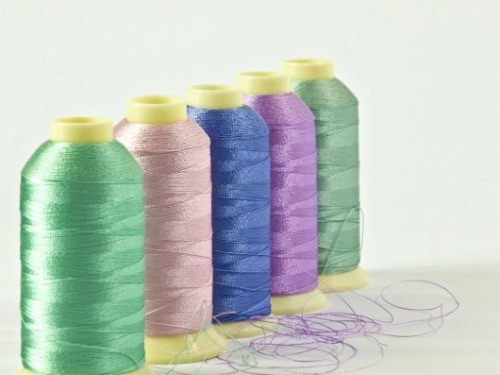How to Test the Actual Strength of 40s/2 100% Spun Polyester TFO Overlocking Thread
Testing the actual strength of 40s/2 100% spun polyester TFO overlocking thread requires designing scientific detection methods based on real usage scenarios, rather than relying solely on single breaking strength data. First, cut a 50cm thread sample and place it in a standard environment (20℃ temperature, 65% humidity) for 24 hours to eliminate environmental impacts on test results. During testing, fix the thread sample on a tensile testing machine and stretch it at a constant speed of 300mm per minute, recording the maximum tensile force at break. High-quality 40s/2 spun polyester TFO thread should withstand a pulling force of no less than 4.5kg in this test. More importantly, simulate repeated stress during overlocking: bend the thread sample 100 times before tensile testing, observing strength attenuation. Threads with an attenuation rate below 10% are more suitable for high-frequency overlocking operations. Additionally, test the thread’s strength retention in a wet state: soak the sample in 30℃ warm water for 30 minutes, dry it, and test. High-quality threads should limit strength loss to within 5% to meet post-washing usage needs of fabrics.
How to Improve the Heat Resistance of High-Count Spun Polyester Overlocking Thread
Enhancing the heat resistance of high-count spun polyester overlocking thread involves both pre-use treatment and in-process process control.Before use, place the thread in a 40℃ oven for 2 hours of constant temperature treatment to stabilize fiber molecular arrangement, enhancing high-temperature stability—especially suitable for overlocking fabrics requiring subsequent high-temperature ironing. During overlocking, control the needle plate temperature below 80℃; install small heat sinks near the needle plate to regulate temperature, preventing strength loss from prolonged frictional heating of the thread. For fabrics needing high-temperature setting (e.g., chemical fiber fabrics), select 40s/2 spun polyester TFO thread containing heat-resistant agents, or bake overlocked seams at low temperature (60℃ for 15 minutes) after overlocking to align thermal shrinkage rates of thread and fabric, reducing seam deformation after high-temperature processing. Furthermore, store threads away from direct sunlight or heat sources to maintain their original heat-resistant properties.
Tension Adjustment Tips for 40s/2 Polyester Overlocking Thread on Overlock Machines
Tension adjustment of 40s/2 polyester overlocking thread on overlock machines must flexibly adapt to fabric thickness and stitch length to form flat, secure seams. For thin fabrics (e.g., chiffon, silk), set upper thread tension to 3-4 levels and lower thread tension to 2-3 levels, while slowing fabric feeding speed to avoid fabric wrinkling or overly tight seams from excessive tension. For thick fabrics (e.g., denim, canvas), increase upper thread tension to 5-6 levels and lower thread tension to 4-5 levels, paired with thicker overlock needles to ensure seams penetrate the fabric with sufficient strength. During adjustment, test-sew 3-5cm on scrap fabric to check stitch uniformity: loose upper thread causes floating threads, while excessive tension leads to fabric shrinkage;Improper lower thread tension results in stacking or breakage on the reverse side.Additionally, when overlocking curved sections,temporarily reduce tension by 1-2 levels and cooperate with manual fabric feeding to prevent uneven stitch density at corners, ensuring consistent overall seams.

Matching Points Between Spun Polyester TFO Overlocking Thread and Different Fabrics
Matching spun polyester TFO overlocking thread with different fabrics requires focusing on elasticity, abrasion resistance, and color coordination between thread and fabric to achieve functional and aesthetic unity. For knitted fabrics (with high elasticity), choose 40s/2 spun polyester TFO thread with moderate twist (300-350 twists per meter) to avoid restricted fabric movement from insufficient thread elasticity or loose seams from excessive elasticity. For woven fabrics, adjust thread tension based on fabric density: high-density fabrics (e.g., poplin) suit slightly higher tension to embed seams into fabric texture; low-density fabrics (e.g., linen) require lower tension to prevent fabric distortion from thread pulling. In color selection, pair dark fabrics with threads of the same color or one shade darker; light fabrics can use near-tone threads to reduce color difference. Decorative overlocking may use contrasting threads, but ensure thread color fastness to prevent staining during ironing or washing.
How to Handle Pilling Issues of High-Quality Overlocking Thread
Pilling of high-quality overlocking thread mostly stems from improper friction or unbalanced process parameters, requiring treatment in pre-use, in-use, and post-use stages. Before use, soak threads in a special anti-pilling solution (containing silicone) for 10 minutes, air-dry, and use—this forms a protective film on fibers, reducing fuzz from friction. During overlocking, ensure needle-thread compatibility: 40s/2 thread suits size 9-11 needles; overly large needle holes increase thread friction, while undersized ones may scratch threads causing pilling. For minor existing pilling, gently brush along seams with a soft brush after overlocking to remove surface fuzz; for severe pilling, use a low-temperature iron (≤110℃) to lightly press, using heat to flatten fibers and improve appearance. Additionally, select combed spun polyester TFO thread (with uniform fiber length and few short fibers), which inherently has better anti-pilling performance to minimize issues at the source.






